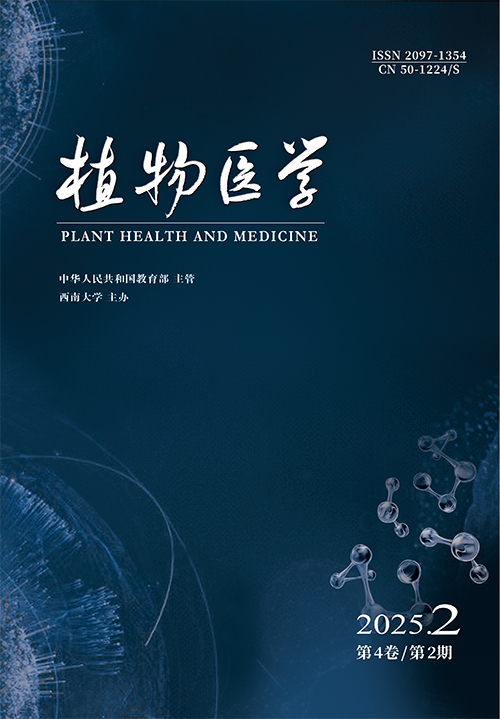WEI Mingfeng, CHANG Fangjuan, YAO Zhong, et al. Population Dynamics and Control Strategy of Cacopsylla chinensis on Pyrus bretschneideri in Yuncheng(China)[J]. PLANT HEALTH AND MEDICINE, 2021, (6): 45-49. doi: 10.13718/j.cnki.zwys.2021.06.009
| Citation: |
WEI Mingfeng, CHANG Fangjuan, YAO Zhong, et al. Population Dynamics and Control Strategy of Cacopsylla chinensis on Pyrus bretschneideri in Yuncheng(China)[J]. PLANT HEALTH AND MEDICINE, 2021, (6): 45-49. doi: 10.13718/j.cnki.zwys.2021.06.009
|
Population Dynamics and Control Strategy of Cacopsylla chinensis on Pyrus bretschneideri in Yuncheng(China)
-
Cotton Research Institute, Shanxi Agricultural University, Yuncheng, Shanxi 044000, China
More Information
-
Received Date:
28/09/2021
-
MSC:
S436.612.2
-
Abstract
Cacopsylla chinensis is a monophagous sucking pest on pear trees. The authors of this paper investigated the population dynamics of C.chinensison Pyrus bretschneideri in Yuncheng, Shanxi from 2018 to 2019. The results showed that the number of C. chinensis eggs had two peaks, appearing from early to mid-May and from late June to early July. C. chinensis nymphs peaked from mid-April to late April and from early to mid-June.The hibernation period of the overwintering adults ended from early March to mid-March, and the first generation of adults occurred from early May to mid-May.Taking the characteristics of C. chinensis into consideration, a control strategy of "twice control and one prevention" is proposed, which provides a guiding basis for the integrated insect management in pear orchards.
-

-
References
|
[1]
|
张翠疃,徐国良,王鹏,等.中国梨木虱危害规律的研究[J].华北农学报, 2002, 17(S1):17-22.
Google Scholar
|
|
[2]
|
杨集昆,李法圣.梨木虱考——记七新种(同翅目:木虱科)[J].昆虫分类学报, 1981, 3(1):35-47.
Google Scholar
|
|
[3]
|
SEEMVLLER E, SCHNEIDER B.‘Candidatus phytoplasma Mali’,‘Candidatus phytoplasma Pyri’and‘Candidatus phytoplasma Prunorum’, the Causal Agents of Apple Proliferation, Pear Decline and European Stone Fruit Yellows, Respectively[J]. International Journal of Systematic and Evolutionary Microbiology, 2004, 54(pt4):1217-1226.
Google Scholar
|
|
[4]
|
HILDEBRAND M, DICKLER E, GEIDER K. Occurrence of Erwinia Amylovora on Insects in a Fire Blight Orchard[J]. Journal of Phytopathology, 2000, 148(4):251-256.
Google Scholar
|
|
[5]
|
王立如,徐绍清,徐永江,等.中国梨木虱的空间分布和抽样技术[J].植物保护, 2004, 30(1):69-71.
Google Scholar
|
|
[6]
|
JENSER G, SZITA É, BALINT J. Measuring Pear PsyllaPopulation Density (Cacopsylla pyri L. and C. pyricola F rster):Review of Previous Methods and Evaluation of a New Technique[J]. North-Western Journal of Zoology, 2010, 6(1):54-62.
Google Scholar
|
|
[7]
|
李庆,蔡如希.温度和湿度同梨木虱生长发育和繁殖的关系[J].四川农业大学学报, 1995, 13(2):127-129.
Google Scholar
|
|
[8]
|
SHALTIEL L, COLL M. Reduction of Pear Psylla Damage by the Predatory Bug Anthocoris nemoralis(Heteroptera:Anthocoridae):The Importance of Orchard Colonization Time and Neighboring Vegetation[J]. Biocontrol Science and Technology, 2004, 14(8):811-821.
Google Scholar
|
|
[9]
|
魏明峰,姚众,刘珍,等.梨休眠期中国梨喀木虱种群动态及防控措施研究[J].河南农业科学, 2019, 48(1):72-76.
Google Scholar
|
-
-
Access History






 DownLoad:
DownLoad: